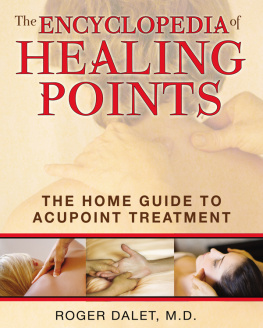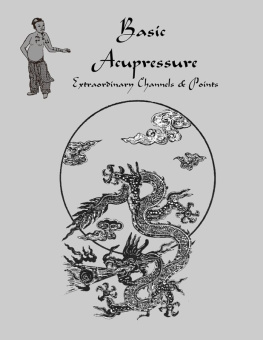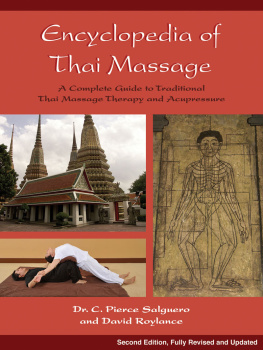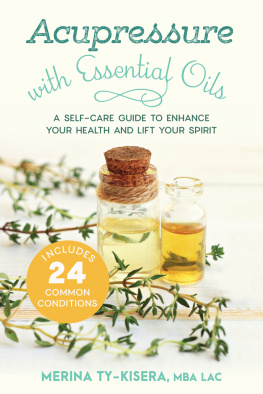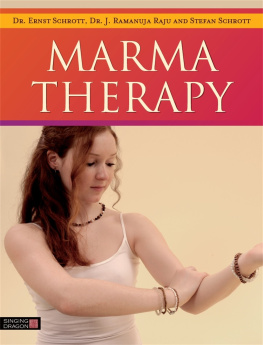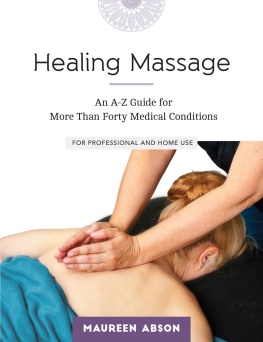The ENCYCLOPEDIA of
HEALING
POINTS
THE HOME GUIDE TO
ACUPOINT TREATMENT

ROGER DALET, M.D.
Translated by Jon E. Graham

Healing Arts Press
Rochester, Vermont Toronto, Canada

Introduction

THIS BOOK IS directed at both health professionals and individuals seeking to take control of their own health. Some of the techniques are quite convenient for home use, while othersgenerally those directed at more serious conditionswill require the guidance of a trained practitioner.
I have selected only the most common illnesses and disorders for inclusion, and have arranged this book in a way that should make it easy for the reader to use regularly. Each condition is accompanied by a brief description of its symptoms and the conventional treatment normally applied to them. I then describe for each ailment the acupuncture points that Chinese medicine would commonly recommend for such a condition, and any additional points that I have found to be particularly effective in my own long experience as a practitioner. The points are then divided into principal and secondary points. As a general rule, stimulation of the principal points is enough to provide an active therapeutic effect. The secondary points are used to reinforce or adjust the effects of the primary points.
HOW THE POINTS ARE STIMULATED
While acupuncture with fine stainless steel needles is still the most well-known method of stimulating acupoints, there are many other ways, several of which can be easily accomplished by lay readers. This book focuses on two simple methods that are safe and easy to practice at home.
Simple Manual Massage
Place the tip of your thumb or index finger on the point indicated (this can even be an approximate placement) and lightly vibrate your finger or rotate it clockwise while pressing down sharply. More precise pressure can be applied on a point by using the eraser end of a pencil or a small thimble. Success is obtained when the symptomthe pain or disorder or sick feelingdisappears. For treatment of chronic illnesses you should perform this same massage twice a day for two to ten minutes at a time.
Electrical Stimulation
For many years, researchers have sought to develop alternate ways of stimulating acupoints. The application of electrical current began in China in the 1930s; today, this effort has been expanded by the advent of newer, simpler, and more reliable machines. Whereas the original devices required that electrodes be attached to needles inserted in the skinand therefore could only be used by professional acupuncturistssome of the more modern stimulators can be applied directly to the skin, and can thus be used by nonprofessionals.
THE EVOLUTION OF ACUPOINT THERAPY
Acupuncture appears to be the oldest system of medicine on the planet. Its origins are lost in the dawn of time, but archaeological discoveries and subsequent extensive research performed in China show evidence of acupunctures use more than two thousand years ago. In written works dating from before the birth of Christ, researchers have discovered clear discussions of acupuncture needling.
Acupressurethe stimulation of acupuncture points by handmay even have predated the use of needles. Without clear written documents, however, it is hard to know exactly how these styles of medicine evolved.
How is it that we have no written documents recording the origins of acupuncture or acupressure? The major reason is the draconian laws established by a Chinese ruler, Emperor Huang-Ti, around 200 BCE. This sovereign ordered all the books existing in China at this time destroyed, because he wished for no evidence to survive from the time preceding his rule.
On the other hand, he did take pains to see that medical treatises were written. He literally imposed the method of their creation when he wrote: I desire to put an end to the use of medicines that poison I wish only the mysterious metal needles to be used.
If these needles were a mystery to him, just imagine how much greater their mysteries are for us!
Following the death of this terrible autocrat, those who outlived his reign compared what they remembered of the documents he had destroyed and wrote the first acupuncture books, primarily the Nei Jing and the Su Wen. While the instructions in these books sometimes match, they often diverge and even contradict each other. For this reason the contradictory nature of traditional Chinese medicine is one of the first stumbling blocks encountered by the Westerner seeking to master its principles.
Here is the second obstacle for a Westerner: Chinese medicine is a philosophical medicine. In fact, the Chinese strove to integrate their medicine not in an anatomical or biological context but in accordance with their philosophy; this means that basic medical principles include discussions of the forces of nature, balance among the elements, treatises on heat and cold, etc. In addition, sacred aspects of numerology were also employed in the study of medicine.
The Chinese have always been and remain fascinated by figures. One need only mention the hundred flowers, the band of four, the four modernizations, and so forth. To the Chinese mind, the harmony of the world is based upon the combination of numbers. Five, nine, and twelve each have a range of esoteric associations, for instance, as well as correspondences in all the other domains of life: astronomy, agriculture, daily tasks and medicine.
Corresponding to the five fundamental elements and the five cardinal directions (North, East, South, West, and the Center) are the five flavors, the five odors, and the five primordial organs of the human body. Everything combines this way in a perfect harmony that the Chinese mind finds to be the summit of satisfaction.
But this veritable osmosis of medicine and philosophy, satisfying as it may be to the Chinese mind, is not readily acceptable to the Western mind. In fact, its application brings into play rules of thought and reasoning that are quite different from the analytical and logical form of reasoning to which we are accustomed.
The rules for using Chinese medicine appeal to notions that seem purely speculative to us: points and meridians, wonderful vessels, ancestral or perverse energies; these are all words that bring to mind the animal spirits and malefic virtues of our medieval doctors.
Then there is a third shoal for the Western mind to negotiate: Chinese medicine is an esoteric medicine. Point selections and treatment strategies are often based on abstract, esoteric principles like the name of a specific point, or astrological calculations.
So how could a style of medicine with these three distinguishing features (contradiction, philosophy, and esoteric nature) not be antithetical to the Western medical mind, which is so specifically keen on deductive reasoning and scientific knowledge? How did things develop to allow a medicine like this to get a strong foothold in our part of the world?
The answer is simple: it is effective. This medicine with all its original features has traveled through 1,500 years of history unchanged, and survived this way until around the 1960s. It was in this way that it was able to reach the West by several successive channels. When used following the Chinese rules, acupoint therapy attacks illnesses and can improve or cure pathological states with an ease that is often disconcerting. More impressive is the fact that this medical modality is performed almost without any pain, toxicity, or medication. It has therefore gained the adherence of many Western doctors. But criticisms and sarcastic jibes have not been lacking. Let me just say that twenty years ago you needed a thick skin and a lot of belief in yourself to admit to being an acupuncturist. Then, all of a sudden, everything changed. And this change cameas it should havefrom China, its land of origin.
Next page
